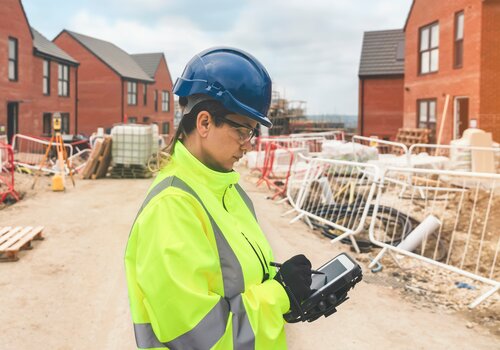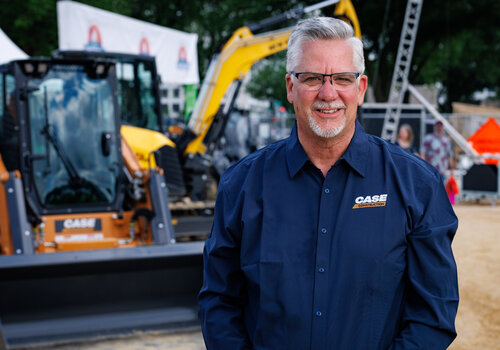Benefits of smart helmets
Today, hard hats can be equipped with newer, even high-tech items, such as high-definition cameras, smartphones, sensors, an internet connection, voice command, GPS, RFID (radio frequency identification), fall detection, and a panic button.
The latest generation of accessories allows contractors to be more productive and safer just as earlier generations did. This evolution of hard hats is really the evolution of accessories.
“Seeing specific pieces of the design or selected discipline data in mixed reality onsite helps contractors ensure they coordinate with different trades as things are built to prevent errors and catch ones that are made right away,” says Nicolas Fonta, Director & General Manager, Augmented & Virtual Reality (XR) at Autodesk.
Although increasingly popular, not all smart helmets have the same features or are suited for the same applications. Consider four of the leading smart helmets available on the market today.
1. Guardhat Communicator
The Guardhat Communicator smart hardhat by Lantronix Inc. connects workers with a remote command center via sensors, a camera, and microphones.
The company says they re-envisioned the hardhat as a wearable device at the edge of an end-to-end safety system, and the Guardhat Communicator is the result of that endeavor.
The Guardhat system is composed of the Guardhat Platform (the software) and a growing number of wearable devices and integrations. The software has a set of prebuilt and customizable KPI dashboards, drill-down analytics, and downloadable reports. It’s a modular software platform capable of absorbing, managing, and analyzing unstructured data.
It also provides videography, photography, two-way voice communication, video calls, GPS, and a panic button in case the wearer is injured or in distress.
The Guardhat Communicator is ready to be used out-of-the-box but can be configured for various applications. It can be deployed on-site or on any of the major cloud-based PaaS providers.
2. HMT1
The HMT-1 from RealWear is a wearable computer that complies with ANSI-type standards and construction personal protective equipment regulations.
The HMT in the model name stands for head-mounted tablet and it provides a mobile heads-up display for the wearer. This allows the end-user to take pictures with it and send the photos via an internet connection, as well as two-way communication.
This device is really handy for remote work, especially for working with technicians and other experts. When a machine breaks down in the field, the operator can wear the HMT-1 and work with a technician who is diagnosing the problem remotely using the information collected by the HMT-1. Similar examples could be created for engineers, architects, product experts, and even customers.
3. Smart Helmet from Excellent Web World
The Smart Helmet from Excellent Web World collects and communicates jobsite data, as well as personal data to create a safe workplace and healthy workforce.
The helmet comes equipped with GPS, an RFID (radio frequency identification) sensor, an ultra-wideband (UWB) sensor, and an around view monitor (AVM) to track workers’ whereabouts, activities, environment, and personal health.
Several sensors on the helmet are capable of detecting air quality, which helps alert the wearer with an alarm (and the on-site safety officer via an alert) to the presence of hazardous gases and pollution. This feature is handy for people working in tunnels or confined spaces, around gas lines, etc.
The device also measures the wearer’s (skin) temperature and heart rate as part of its health monitoring service. A gyroscope sensor on the helmet knows whether a person is upright, laying down, or upside down and its accelerometer sensor detect direction and speed. Both features are used to detect slips and falls.
4. XR10 with HoloLens 2
The XR10 with HoloLens 2 is the result of a collaboration between Trimble and Microsoft. The HoloLens 2 is a purpose-built, self-contained holographic device that offers mixed reality on the jobsite.
Mixed reality on the jobsite is becoming increasingly important in project managers’ efforts to verify as-builts and measure jobsite progress.
“On the construction jobsite, there are numerous opportunities for XR, but the main value is in ‘design and build coordination’. This brings the design within mixed reality to professionals in the real world and allows them to perform QA/QC on the jobsite as things are built, enabling them to look for execution errors,” says Fonta.
“It’s also very handy when used by the trades. Now, when a plumber installs pipe, they can see with the HoloLens 2 where exactly their pipe needs to go and all other items, such as ventilation and electrical will be installed, so they will never cause an issue with the placement of the pipe.
Finally, it can be very handy in helping troubleshoot issues in the field. If, in the above example, the pipe installer discovered an obstacle where the pipe was supposed to be placed. The obstacle isn’t in the blueprints. The pipe installer could move the pipe over a few inches. However, there’s no way for the pipe installer to know if this movement will impact other trades without either initiating a string of texts, phone calls, and emails or by using mixed reality, the pipe installer can solve the issue in the field.












